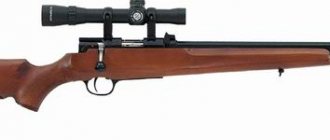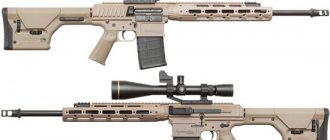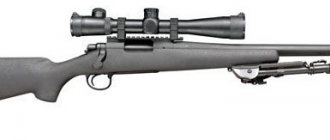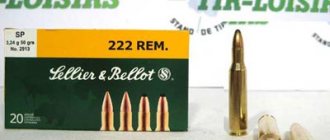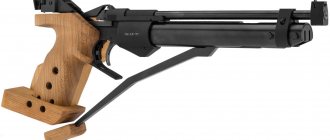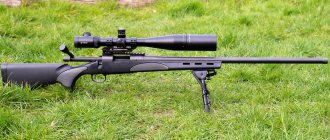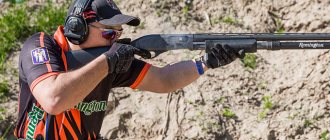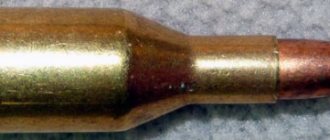| .22-250 Remington | |||
| Type | Rifle | ||
| Place of origin | USA | ||
| Production history | |||
| Designer | Grosvenor Watkins, J. E. Gebbie and J. Bushnell Smith | ||
| Designed by | 1937 | ||
| Manufacturer | Remington | ||
| Produced | 1965-Present Time | ||
| Options | .22-250 Ackley Improved | ||
| Characteristics | |||
| Parent case | .250-3000 Savage | ||
| Type of shell | Rimless, bottleneck | ||
| Bullet diameter | 0.224 in (5.7 mm) | ||
| Neck diameter | 0.254 in (6.5 mm) | ||
| Shoulder diameter | 0.414 in (10.5 mm) | ||
| Base diameter | 0.470 in (11.9 mm) | ||
| Rim diameter | 0.473 in (12.0 mm) | ||
| Case length | 1.912 inches (48.6 mm) | ||
| Full Length | 2.35 inches (60 mm) | ||
| Rifled turn | 1–12, 1–14 | ||
| Primer type | Big rifle | ||
| Ballistic characteristics | |||
| 1585 ft⋅lbf (2149 J) | |||
| 50 gr. (3.2 g) SP | 3,945 ft/s (1,202 m/s) | 1728 ft⋅lbf (2343 J) | |
| 55 gr. (3.6 g) SP | 3,786 ft/s (1,154 m/s) | 1.751 ft⋅lbf (2.374 J) | |
| 60 gr. (3.9 g) BT | 3,580 ft/s (1,090 m/s) | 1,708 ft⋅lbf (2,316 J) | |
| 64 gr. (4.1 g) Power Point | 3,500 ft/s (1,100 m/s) | 1741 ft⋅lbf (2360 J) | |
.22-250 Remington CIP maximum cartridge sizes.
All dimensions are in millimeters (mm) / imperial units (inches).
.22-250 Remington
is a very high velocity (capable of reaching over 4,000 feet per second), short action, .22 caliber rifle cartridge primarily used for varmint and light game hunting.
Although it is sometimes used on deer, it is not recommended. [2] Some jurisdictions prohibit the use of cartridges smaller than 6 mm (0.243 in) for deer hunting. This cartridge is also sometimes called the .22 Varminter
or
.22 Wotkyns Original Swift
. [3] Along with the .220 Swift, the .22-250 was one of the high-velocity .22 caliber cartridges that gained a reputation for causing distant injuries known as hydrostatic shock in the late 1930s and early 1940s. [4] [5]
Description of the Remington 700 VTR carbine
This is a bolt-action carbine, the design of which is borrowed almost unchanged from the equally legendary weapon - the Mauser 98 carbine. The decoding of the model abbreviation gives you an idea of what the Remington 700 VTR is.
- V – Varmint (varminting) , a type of hunting or sport shooting at small animals that are considered pests. For example, rats, groundhogs, field dogs, rabbits, skunks, stray dogs, foxes, coyotes. Its feature is very long distances - up to a kilometer, so the varmint rifle has a high-quality long barrel, and is equipped with an optical sight of high magnification and aperture. For them, small-caliber or weakened cartridges are used, the light bullets of which have a high initial speed, and their flight trajectory is close to flat. Common practice is to use a bipod or shoot from a prone position.
- T - Tactical , the carbine has a shortened barrel, so the effective shooting range is reduced to 300 meters, almost half of that accepted in this sport.
- R – Rifles , rifle.
A special feature of the design of the carbine is a match (thick-walled) barrel, which has a triangular cross-section. At its end there is a muzzle brake, which consists of three vertical cuts to the barrel bore.
Remington 700 VTR carbine
Advantages and disadvantages
- A very simple design and, as a result, high reliability of the weapon. The bolt and the inner surface of the receiver are coated with physical properties similar to Teflon. Therefore, the reloading mechanism does not require lubrication and remains operational even when heavily soiled.
- The massive match barrel of an unusual triangular shape has excellent internal ballistics. Despite the cantilever design, it practically does not vibrate when fired and is effectively cooled.
- The presence of a muzzle brake on the barrel is both a plus and somewhat a minus. It significantly reduces recoil when firing. However, its position cannot be changed, nor can this device be completely abandoned if such a desire arises, because the slots further shorten the barrel and worsen the ballistic qualities of the weapon.
- The carbine magazine is a lid with a leaf spring, so you can only load cartridges from above, through the ejector window in the receiver, which is not very convenient if a rail is installed, and not high brackets for an optical sight.
- Very simple logic of the firing mechanism fuse. His flag has only two positions: back “Stop” and forward “Fire”.
- The length of the trigger stroke is very short; according to the figurative expression from the instruction manual for the Remington 700 VTR, it is “like a fragile piece of ice.” This is a common practice for sporting weapons, but not all hunters like it.
- The force on the trigger can be adjusted; the screw slot is located at the base of the trigger and is accessible without additional manipulation.
- The end of the bolt lever - a “tablet” convex along the edge or a triangular knob with slots in the latest models - protrudes too far beyond the dimensions of the stock. For varminting, this is quite normal, but during running hunts it will certainly cling to branches, which is inconvenient and somewhat dangerous.
- All the main elements of weapon manipulation - the trigger, the bolt release levers and the magazine ejection levers - are located inside a rather narrow trigger guard. This is convenient for a leisurely shot made from a rest, but during a dynamic hunt with offhand shooting it can cause a fatal failure.
- The stock of the carbine is made of impact-resistant plastic; there are elastron inserts on the fore-end and pistol grip, which have good frictional qualities and allow you to securely hold the weapon.
- The forend has a number of ventilation holes that increase the effectiveness of barrel cooling. It is trapezoidal in cross-section, with a wide flat base that allows you to securely fix the weapon on any rest. It has a pair of ring swivels that are convenient for attaching a bipod.
- At the same time, it is worth noting that the shape of the stock is inconvenient for offhand shooting; the butt is absolutely straight, its ridge is parallel to the axis of the barrel.
The carbine does not have external sighting devices, so it is of little use for dynamic driven hunting with short shooting distances.
An overview of the Remington 700 VTR carbine is given in this video:
Purpose
The carbine can be used for sport shooting and ambush hunting of rodents, rabbits, and small ungulates.
Varieties
The stock can be dark olive or dark sand color.
Performance[edit]
A standard factory loaded .22-250 Remington can propel a 55 grain (3.56 g) Spitzer bullet at 3,680 ft/s (1,122 m/s) with an energy of 1.654 ft lbf (2,243 J) . [9] Many other loads with lighter bullets are used to achieve velocities in excess of 4,000 ft/s (1,219 m/s) while still maintaining effective energy for use in hunting small game and medium-sized predators.
The .22-250 is currently the fastest cartridge in production, surpassing the .204 Ruger. This cartridge is loaded by Hornady to their Superformance line and is a 35-grain non-toxic varmint bullet that produces 4,450 fps (1,356 m/s) from a 24-inch barrel.
It is especially popular in the western United States, where high winds often reduce the effectiveness of other varmint walks for prairie hunting. Many US states have minimum caliber restrictions for large game such as deer, although most states allow the use of a big game cartridge.
Specifications
| 223 Rem | 22-250 Rem | 260 Rem | 308 Win | |
| Type | Bolt-action carbine | |||
| Barrel length (mm) | 559 | |||
| Rifling pitch | 9” | 14” | 8” | 10” |
| Magazine capacity | 5 (+1 in chamber) | 4 (+1 in chamber) | ||
| Lodge | Semi-pistol, plastic, with elastron inserts | |||
| Weight, kg) | 3,2 | 3,2 | 3,4 | 3,6 |
| Length (mm) | 1050 |
Commercial adoption[edit]
In 1963, the Browning Arms Company began calibrating its Browning High Power Rifle in .22-250, then the Wildcat cartridge. This was a risky but historic move on Browning's part, as there was no commercial production of the .22-250 at the time. John T. Amber reporting on the development of the Browning rifle in Gun Digest
1964, called the event "unprecedented." “To my knowledge,” he wrote, “this is the first time that a first-line gun manufacturer has offered a rifle chambered for a cartridge that it or any other ammunition manufacturer cannot supply.” Amber foresaw difficulties for . He said he had an order for one of the first heavy-barrel models, expected in June 1963, and added, "I can't wait!" [6]
Two years later in 1965, Remington Arms adopted the .22-250, adding the "Remington" name and chambering their Model 700 and 40 match XB rifles for the cartridge along with a line of commercial ammunition, thus establishing its commercial specification. [7]
The .22-250 was the first non-Wetherby caliber offered in the unique Weatherby Mark V rifle.
Design
- Carbine with a longitudinally sliding (bolt) bolt. The bolt cylinder is fixed, with two lugs.
- The stem of the shutter is coated with a composition similar to Teflon.
- The receiver is steel, milled from a single piece, and is coated inside with the same compound as the bolt. The connection to the barrel is permanent.
- The barrel is suspended (cantilever), the breech is round, after it up to the muzzle its cross-section has a triangular shape. Near the muzzle, three vertical slots are made up to the bore, forming a muzzle brake.
- Trigger mechanism with adjustable trigger force. The safety is two-position, its flag is located behind the bolt handle. The trigger looks like a curved plate.
- The magazine hopper emptying lever is located inside the trigger guard, at its front branch. The lid is equipped with a flat metal spring.
- The cartridges are placed in the hopper from above, through the cartridge ejector window.
- Also inside the trigger guard, but at the top, there is a bolt locking lever, when pressed, it can be removed from the receiver.
- The stock is plastic, semi-pistol type. The stock has a straight comb without protrusions, which is parallel to the axis of the barrel. There is a shock-absorbing non-adjustable butt plate.
- The forend is trapezoidal in shape, with ventilation holes at the top and a wide base on which two rings (swivels) are installed for attaching a bipod.
- There are no external sighting devices. The receiver has four metric threaded holes for mounting brackets or rails for optical sights.
Remington 700 VTR Bipod
Family of small calibers and their role in hunting
10.04.2012
The laws of the development of dialectics have not yet been canceled. And as for hunting cartridges, over the past 50 years the trend in their improvement has been rapidly moving both towards increasing calibers, as a result of which we received the giant cartridge created in 1988 - .700 NE (17.78 mm), and towards their reduction is the .17HMR (4.3 mm) caliber cartridge, developed in 2002.
Attempts were made to create ultra-small calibers, such as .14-222 with a bullet diameter of 3.55 mm, but they did not cause a fit of enthusiasm among hunters due to the extreme limitations of their use. For the convenience of analyzing material devoted to small calibers, we will not distinguish between the group of rimfire and centerfire cartridges, since for us the characteristics of ammunition based on increasing caliber and their power are important. In addition, we will not focus on sporting, hunting and match cartridges, simply because this is a separate and extensive topic.
Many will agree that the topic of small calibers often causes debate among hunters until they are hoarse. When more than two hunters gather, they often share “personal” action-packed memories, and some argue that, for example, by shooting locally from a distance of up to 50 meters, you can take any animal of our fauna with a 5.6 mm rimfire rifle. All this is accompanied by “true” examples from practice. I would like to note on my own that in the hunting literature one can actually find descriptions of cases of hunting moose, bears, and in Africa even leopards with a .22 LR rimfire caliber gun.
But this is not the limit. I know of two reliable cases in which a wild boar weighing 110 kg and a female roe deer were killed with a 4.5 mm pneumatic weapon, shot in the head and eye respectively. With elephants it is more difficult: the famous elephant hunter Bell felled a considerable number of thick-skinned giants with a 6.5x54 Mannlicher-Schönauer caliber weapon. No one should repeat his exploits, as we can also recall situations where even weapons of 375 H&H and .416 Remington Magnum calibers, including a doublet, could not stop an attacking elephant.
In our article we will look at two groups of calibers; ultra-small (from 4.3 to 5 mm) and a group from 5.6 to 6 mm. Common ultra-small calibers include the .17 Remington, .17 HMR, and .204 Ruger.
Ultra-small caliber group: from 4.3mm to 5mm
.17 Remington (4.3 mm x 45).
Appeared in 1971 thanks to the efforts of , which in 1965-1966 experimented with the 5.6 mm x45 military cartridge. The new cartridge was conceived as a sporting and hunting cartridge with an expansive bullet weighing 1.3 and 1.62 g and an energy of about 1227 joules. At the same time, a ghoul weighing 1.6 g develops a speed of 1230 m/s, and a bullet weighing 1.3 g reaches almost 1300 m/s! The cartridge provides excellent flatness and accuracy. At a distance of 300 m, the bullet still maintains a speed of about 580 m/s and an energy of 275 joules while decreasing from the aiming line by only 18 cm.
Suitable, in addition to hunting traditional varmints, crows, and foxes. However, in real hunting conditions it is unlikely to be effective at a distance exceeding 200 m, since all light bullets are very sensitive to gusts of side wind, and excellent accuracy in a closed shooting range can result in nothing in the hunting grounds.
The .17 Remington cartridge also has a bad reputation as a “barrel burner,” because the high velocity of the bullet and severe pressure in the bore lead to increased wear, which affects the accuracy of the cartridge after just a few hundred shots.
.17 Hornady Magnum Rimfire (4,Зmmх27R)
The cartridge was first introduced by Hornady in 2002 as a new rimfire hunting ammunition with increased accuracy. The weight of the expansive bullet is 1.1 g, it develops an initial speed of 777 m/s and has an energy of 332-340 joules. For comparison, a 2.6 g bullet from the well-known .22 caliber small-caliber cartridge has a muzzle velocity of 330 m/s and an energy of 144 joules.
The .17 HMR is only suitable for hunting small game and birds. In 2005, I purchased a carbine chambered for this cartridge and thoroughly tested the effect of the bullet in practice. Firstly, I made sure that the direct shot of this cartridge is about 130 m. The sound of the shot is not loud, there is no recoil. Secondly, the accuracy at a distance of 100 m was 22 mm, which makes it possible to shoot down pigeons and even sparrows at this distance. However, even at a distance of 100 m, the energy of the bullet is noticeably lost. For the sake of experimentation, I placed an old shovel at the shooting range and shot at it at a distance of 50 and 100 m, respectively, with a V-Max bullet. At a distance of 100 m, the hollow bullet no longer penetrated the shovel.
While on a hunt, I casually shot two gray crows, swarming in the garbage, from a distance of 75-80 m. Later, a fox and a hare were taken from the carbine. The fox had to be shot twice, although the first bullet hit the body at a distance of 30 m. In both cases, the bullet did not make an exit hole.
So, we can conclude that the .17 HMR cartridge is superior in basic characteristics to our traditional .22 caliber cartridge and, perhaps, more effective than the .22 Winchester Magnum (.22 WMR) cartridge. Now in the West they are considering the .17 HMR cartridge as a modern competitor to the .22 WMR cartridge.
.204 Ruger (5 mm x47)
The cartridge first appeared as the fruit of a joint cooperation between the American companies Hornady and Ruger in 2004. Like many other cartridges of American origin, its appearance was preceded by experimental “wildcats”, that is, made in an artisanal way. Since competition in the American firearms market is always great, not a single cartridge can appear there by accident, without an attempt to “fit in” or occupy someone else’s niche. In this case, it should be considered as a competitor to the .17 Remington cartridge (4.3 mm x 45) from the same group.
In terms of hunting purpose and effectiveness, it can be compared with such more powerful cartridges as .222 and .223 Remington, not to mention the .17 Remington. What advantages can you see from this 5mm cartridge? It gives a bullet weighing 2.6 g an initial speed of 1190 m/s and an energy of more than 1800 joules. A direct shot is approximately 200 m, which indicates excellent bullet persistence. At the same time, at a distance of 100 m, the bullet rises only 2 centimeters above the aiming point, which allows you to shoot small animals at a distance of 200 m without making aiming adjustments.
However, unlike the .17 Remington cartridge, the manufacturer this time managed to mitigate the problem of increased barrel wear through the use of new gunpowder, which, when burned, produces a lower temperature than before.
In summary, of the cartridges under 5.6mm, the .204 Ruger is probably the best for small game hunting and can be used to hunt European roe deer at ranges up to 200 meters.
Caliber group from 5.6 to 6 mm
Given the limited capabilities of this article, we will not dwell on the description of cartridges that are currently not of particular interest as hunting cartridges, but will focus on the description of the most common ones. We include the following cartridges in this group: .22 WMR, .22 Hornet, .220 Swift, .218 Bee, 5.6×61 vom Hofe, .222 Remington, .224 Weatherby Magnum, .225 Winchester, .22-250 Remington, .223 Remington, 5.6x57 RWS, .5.6x50(R) Magnum and .223 WSSM, 5.6x39.
.22 Winchester Magnum Rimfire (5.6mm x 27 R)
Despite the fact that the cartridge appeared relatively recently - in 1959, it managed to quickly conquer the entire arms world, and most of the world's manufacturers have the .22 Winchester Magnum in their range. A bullet weighing 2.6 g leaves the barrel at a speed of about 600 m/s, having an energy of 440 joules. Since the soft lead bullet can break off the rifling at this velocity, all bullets for the .22 WMR are made from jacketed bullets, although the bullets themselves are divided into several types, including the highly expansive V-Max.
The cartridge is inexpensive and has little wear on the barrel, but in terms of its hunting purpose, the .22 Winchester Magnum is a “hundred-meter” cartridge, suitable for hunting foxes and large birds. The fact is that the .22 Winchester Magnum rimfire cartridge does not have outstanding accuracy, especially at distances greater than 100 meters. To a large extent, the popularity of the cartridge in the world was facilitated by the fact that a sufficient number of short-barreled weapons were and are being produced for it.
.22 Hornet (5.6 mm x 35 R)
Developed in the early 30s for sporting purposes and was especially popular until the mid 60s. Possessing excellent accuracy, it is also suitable for hunting small animals and large birds. The direct shot (GEE) of the cartridge is 135 m. It is also conditionally suitable for hunting roe deer, however, at a distance of 200 m, the energy of 240 joules for a bullet weighing 3 g is not enough to reliably defeat the animal. From my own practice, I can give an example when I fired a .22 Hornet cartridge at a male roe deer from an Anschutz carbine at a distance of 90 m, and the animal ran as much as 30 meters with its heart pierced. In a similar situation, a shot from a carbine with a .22-250 Remington cartridge interrupted the run of a roe deer after just a few steps. But the .22 Hornet cartridge performed well when hunting marmots. In general, with the advent of more powerful 5.6 mm cartridges, it began to be used much less in hunting carbines, and more and more in European combination shotguns.
.220 Swift (5.7x57)
The cartridge, created back in 1935, still causes controversy and debate - people differ in their assessments. Of course: Hornady recently managed to release the .220 Swift cartridge, equipped with a V-Max bullet weighing 2.6 g, with an initial speed of 1280 m/s and energy of 2122 joules!
While holding the record for speed among 5.6 mm cartridges, the .220 Swift is at the same time a typical barrel destroyer. Accuracy already noticeably decreases after a few hundred shots, so the .220 Swift cartridge is used as a hunting cartridge, not a sporting one. Depending on the equipment, its direct shot (GEE) ranges from 180 to 210 m. For varminting, you should use expansion bullets like V-Max, and for hunting objects such as roe deer, bullets with limited expansion, such as Trophy Bonded Bear Claw weighs 2.6 g. Whatever anyone says about this cartridge, it must be admitted that its characteristics still have a magical effect on the minds of many hunters.
.218 Bee (5.7×33R)
A good hunting cartridge, although not very common today. It was created in 1938 and in its characteristics is close to the .22 Hornet cartridge, but differs from it in a better way. The problem with the cartridge is completely different: Winchester is its only manufacturer, and there is no variety in equipping the cartridge with different types of bullets. It provides a bullet weighing 3 g with an initial speed of about 840 m/s and an energy of 1050 joules with good accuracy at a distance of 150-180 m. Suitable for hunting animals from small sizes to wolves.
.5.6 x61 vom Hofe Super Express
The most powerful of the 5.6 mm cartridges, although not the fastest. It was developed in 1937 in Germany by the Berlin gunsmith Ernest vom Hof.
When developing the cartridge, the goal was to create a long-range hunting ammunition for hunting roe deer and chamois, not counting smaller animals. It must be admitted that vom Hof succeeded in this. The muzzle velocity and energy of a 5-gram bullet are respectively 1130 m/s and 3192 joules. Unfortunately, this wonderful cartridge is not widely used due to the limited production of weapons and cartridges for it.
.222 Remington (5.7 mm x 43)
When this cartridge appeared on the market in 1950, it very quickly spread as a hunting cartridge not only in America, but also in Europe. Possessing high accuracy and power, in terms of the sum of its advantages it has surpassed the popular .22 Hornet and .220 Swift cartridges. The triumphant march of the .222 Remington continued until 1966, until the new commercial hunting cartridge .223 Remington appeared.
Nevertheless, the .222 Remington is still popular; many sporting and hunting weapons are made for it. It is suitable for hunting animals from small to roe deer size. It should not be forgotten that a light high-speed bullet - 3.24 g is subject to deviation from the flight path when encountering minor obstacles in the form of grass and bush branches, etc. Muzzle velocity and bullet energy are within 1000 m/s and 1780 joules.
My subjective opinion is that the .222 Remington cartridge is undoubtedly good, but personally, after two years of hunting with it, I changed my weapon to a carbine chambered for the .22-250 Remington cartridge.
.224 Weatherby Magnum (5.7 mm x49)
In terms of its characteristics, it is extremely close to the well-known .220 Swift cartridge. Despite Roy Weatherbee's titanic efforts to create a cartridge more powerful than the .220 Swift, he never succeeded. Since work on the cartridge lasted a very long time, there is no consensus in the literature when it finally appeared. Most likely this happened between 1963 and 1968.
The cartridge and weapons chambered for this cartridge are produced by Weatherby itself, and the set: weapon + cartridges is quite expensive. In addition, like the .220 Swift cartridge, Weatherby cartridges have the “remarkable” property of quickly deteriorating barrels. Of course, another important thing to remember is that the .224 Weatherby Magnum cartridge has excellent flatness and killability for game weighing up to 60 kg. The muzzle velocity and energy of a semi-jacketed bullet weighing 3.56 g are 1112 m/s and 2201 joules, respectively.
.225 Winchester (5.7×49R)
Began production in 1964. When created, it was considered as a possible competitor to the .220 Swift and .224 Weatherby Magnum cartridges, but it was not possible to surpass them in either power or speed. This is probably why for many decades the cartridge was produced directly only by Olin/Winchester itself. We also produced weapons for it (the famous Model 70). At the same time, the cartridge is not at all bad in accuracy and is not as destructive to the barrel as its well-known competitors.
Allows you to shoot animals weighing up to 50-60 kg at a distance of up to 300 m (preferably up to 200 m). The muzzle velocity and energy of a semi-jacketed bullet weighing 3.56 g is 1088 m/s and 2107 joules.
.22-250 Remington (5.7×49)
The cartridge can conditionally be called the “third generation”, the predecessors of which were the .250 Savage and .22 Varminter. The name of the .22-250 Remington cartridge reflects both of its predecessors. In 1965, its industrial production began. The success of the cartridge was enormous, since in terms of the sum of its advantages: speed, power, accuracy - and, importantly, the number of manufacturers of weapons for it, it had no equal among 5.6 mm caliber cartridges.
Although in its original design and essence the .22-250 Remington is a typical “varminter”, the cartridge is also quite suitable for hunting European roe deer, mouflon and even fallow deer at a distance of up to 200 m. It is necessary to use only cartridges equipped with a Trophy Bonded bullet weight 3.56 g, Nosler Partition weighing 3.89 g or other hard bullets. Using a simple “half-shell” for hunting ungulates sometimes leads to the appearance of problematic wounded animals. The use of shell bullets on ungulates, especially at a distance of up to 100 meters, often leads to their premature destruction, which does not allow them to reach the vital organs of the animal. You can certainly give examples of successful hunts in such cases, but you will not get stable results.
Our own experience of using the Blaser R93 carbine with a sport-hunting barrel chambered for .22-250 Remington in hunting showed that roe deer and mouflon were killed from a distance of up to 180 meters with one shot with a Nosler Partition bullet weighing 3.89 g. The length of the run after shooting In all cases, it did not exceed 25 meters, and the mouflon remained in its place after being hit in the neck. The roe deer were hit in the area of the lungs and heart. Of the seven different rifles I've hunted with over the past five years, only the Mannlicher rifle chambered in the new 7mm WSM chambered the .22-250 Remington for accuracy. The .22-250 Remington cartridge is manufactured by major American ammunition manufacturers as well as in Europe. His equipment is made with bullets of different assortments. For example, the muzzle velocity and energy of a Trophy Bonded bullet weighing 3.56 g is 1097 m/s and 2142 joules.
.223 Remington (5.7×45)
The .223 Remington cartridge is essentially the younger brother of the .222 Remington, as it was originally created as a military model, but based on it. Today it is the most popular 5.6 mm cartridge. What can you say about him? Suitable for hunting all the same animals as the .22-250 Remington, but inferior to the latter in power. It has good flatness, accuracy and low recoil. A wide range of bullets of various designs from 2.6 to 4.5 g are offered. In terms of cost, the cartridge can be called quite budget-friendly. The muzzle velocity and energy of the 3.56 g Trophy Bonded bullet are 945 m/s and 1589 joules, respectively.
5.6×57 RWS
The cartridge was created in Germany in 1964 by re-compressing the barrel of the 6.5 mm x 57 Mauser cartridge. The cartridge turned out to be high-speed, high-pressure and with excellent flatness. The RWS cartridge with a KS bullet weighing 4.8 g has an initial speed and energy of 1040 m/s and 2596 joules, respectively. There is also a version of the welt cartridge for shotguns with flip-up barrels. It was developed taking into account the requirements of German legislation establishing the minimum energy level for hunting ungulates. Shows good results when shooting roe deer, mouflon, chamois and wolves. Due to economic considerations, it cannot seriously compete with the popular American .22 caliber cartridges.
5.6×50 (R) Magnum
The cartridge appeared in 1968 thanks to the joint efforts of two German manufacturers - DWM and Heym as a conditional response to the creation of the .222 Remington cartridge in the USA. More power than the .222 Remington, as well as the ability to load it with a heavier 4-gram bullet, made the 5.6x50 (R) Magnum cartridge very popular among European hunters in a short time. At the same time, its rent-free version did not find many fans.
Designed as a cartridge for roe deer hunting, the 5.6×50 (R) Magnum fully meets the requirements for such hunts at distances up to 200 m. However, it is inferior in power to the American .225 Winchester welt cartridge (5.7×49 R) . The muzzle velocity and energy of a semi-jacketed bullet (Teilmantel) weighing 4.1 g are 900 m/s and 1661 joules, respectively.
.223 Winchester Super Short Magnum (5.7 mm x 42)
A new generation of short magnum cartridges appeared thanks to the creation of new, high-energy powders and the emerging trend to stop the race to design ever longer magnum cartridges. The cartridge appeared at the end of 2002, but it took time to get used to it, since the market for .22 caliber cartridges was already overcrowded. When creating it, gunsmiths proceeded from at least two circumstances. Firstly, in shorter cartridges, gunpowder burns more evenly and creates less turbulent flow in the barrel, which ultimately affects the accuracy of the weapon. Secondly, a shorter cartridge allows you to create a shorter bolt group for a rifle, and therefore make the weapon itself more compact.
Of course, the .223 Winchester SSM cartridge did not appear out of nowhere: the cartridge case was based on the case of the famous African cartridge .404 Jeffery. The cartridge looks a little more powerful than the .22-250 Remington, but covers the same hunting range of game as the .22-250 Remington cartridge: roe deer, chamois, mouflon, fallow deer and wolf. Naturally, it is also suitable for varminting.
The muzzle velocity and energy of a semi-sheathed bullet (Power Point) weighing 4.15 g are 1097 m/s and 2497 joules, respectively. Unfortunately, we have not yet received any feedback from our hunters about the use of the .223 Winchester SSM cartridge in hunting.
5,6×39
The cartridge, developed by designer M.N. Blum, began production in 1962. It was originally developed as a hunting weapon, but during its creation the well-known 7.62×39 machine gun cartridge was used, which is superior in power but inferior in speed. Bars, MTs 18 carbines, MTs 105-01 combination shotgun, etc., chambered for 5.6×39 cartridges. about twenty years ago they enjoyed well-deserved fame among our hunters, until the market was flooded with foreign analogues. Judging objectively, the cartridge has not used all its reserves. Suffice it to remember that the very accurate American cartridge for sports shooting .22 PRS is nothing more than a slightly modernized 5.6x39! Another name for it is .220 Russian. The American prototype is equipped with ballistically more advanced bullets and modern gunpowder.
Some results
5.6×39 is successfully used for hunting animals such as roe deer, wolf, saiga, fox, as well as large birds. Equipped with shell and semi-shell bullets. A half-shell weighing 3.5 g has an initial speed and energy of 925 m/s and 1500 joules, respectively.
Summing up the topic of small-caliber cartridges, it should be recalled that the increase in speed and energy for all .22 caliber cartridges only increases the maximum distance for a shot, but does not in any way expand the boundaries of the cartridge’s use against game. The reason is that this requires the development of new bullet designs that are harder and at the same time expansive. Even jacketed (VM) .22 caliber bullets weighing 3.24-3.56 g when meeting a target at a speed of 900-1100 m/s often collapse before they have time to penetrate deeply. The way to increase the efficiency of cartridges of this caliber follows from the above - you need to significantly increase the speed of the bullet, but this requires serious research work and experiments, which, by the way, are now being carried out, but have not yet been completed.
Being a fan of .22-250 Remington caliber weapons, I realized that it is impossible to make a racing car out of a Zhiguli, and therefore I hunt marmots and foxes with this carbine. As for the roe deer, I keep the shooting distance within 200 m and use the heaviest 3.89 g Nosler Partition bullet for this caliber.
We should not forget that all bullets of .22 caliber cartridges easily deviate from the target when meeting the slightest obstacle and “do not like” side winds. When tracking a wounded animal, you notice that there is often almost no blood. Having not lost any interest in my favorite, the .22-250 Remington caliber cartridge, I still switched to a 6.5 mm caliber weapon for roe deer hunting, but that will be a separate discussion.
Operating principle
- The Remington 700 VTR is loaded by placing cartridges into the magazine hopper through the cartridge ejector window in the receiver.
- To do this, the safety box is moved forward, the bolt handle is raised by 900, and it itself is pulled back all the way.
- After filling the hopper, you can add an additional cartridge to the chamber, for which it is placed on top of the previously placed ones, the bolt moves forward, its handle goes down and is recessed into the groove of the stock above the trigger guard. If this is not required, then you need to hold the last cartridge, sinking it into the hopper and passing the bolt cylinder over it.
- After this, the carbine is ready to fire, as indicated by the end of the firing pin protruding 4 mm from the bolt stem. If an immediate shot is not required, then the safety lever is moved back until it stops, after which not only the trigger is blocked, but also the bolt stem.
- To deactivate the weapon, you need to press the hopper lever (located on the front branch of the trigger guard), unload the cartridges, remove the trigger from the safety catch, pull the bolt and perform a control trigger. All manipulations are carried out strictly in the designated sequence.
The video below will tell you about the characteristics of the Remington 700 VTR rifle and its test:
Disassembly
- Open the magazine hopper lid and unload the cartridges (even if you are sure there are none there).
- Remove the weapon from the safety catch, lift the bolt handle and pull its stem back until it stops.
- Press the button located above the trigger inside the trigger guard.
- Remove the bolt.
- Unscrew the screws on both sides of the trigger guard, separate the barrel with receiver and trigger from the stock.
- Knock out the fastening pins and separate the trigger assembly with the fuse box from the receiver.
Prices and reviews of Remington 700 VTR carbines (including 223 Rem, 308 Win) are given below.
Analogs
- A varmint rifle with a very similar design is produced by the Finnish company Sako. The Sako 75 Varmint carbine has a wooden stock with a Monte Carlo cushion, a barrel length of 600 mm, and the weight of a .308 Win weapon with a loaded magazine is 3.9 kilograms. No other arms company in the world offers triangular match barrels except Remington. Note that Sako also has the popular carbine Sak0-85 Bavaria.
- There are also similar but good varmint carbines on sale: Remington 700 Varmint SF, VLS, CZ 455 Varmint, CZ 527 LUX Varmint, etc.
The video below will show you shooting the Remington 700 VTR at 650 yards:
History[edit]
The .22-250 began life as a wildcat cartridge developed from the .250-3000 Savage case chambered for a .224 caliber bullet. In the early days of the cartridge there were several different versions that varied only slightly from one to the next, including the version developed in 1937 by Grosvenor Watkins, J. E. Gebbie and J. B. Smith, who called their version Warminter 22
. [3]
The .22-250 is similar to the .220 Swift, but has inferior performance. However, it has a much wider application and has a greater variety of commercially available factory ammunition than the Swift. This usually makes shooting cheaper. The smaller powder charge also results in more economical shooting for users who load their own ammunition. Thanks to its rimless design, the 22-250 also feeds more reliably from a box magazine than the rimless Swift.
In 1937, Phil Sharp, one of the first gunsmiths to build a rifle for the .22-250 caliber and long produced the .220 Swift, stated, "The Swift performed best when it was loaded to about full speed," whereas " The Varminter case allows for the most flexible loading ever with a single cartridge. It will handle all speeds from 1500 ft/sec to 4500 ft/sec." [6]
Sharpe credits this performance for his steep 28-degree shoulder. He insisted that the gunpowder burn in the case and not in the neck of the rifle, and also prevent the case from stretching and thickening the neck. “Shoulder angle is considered along with primer, powders, bullets, neck length, case taper, loading density and all other characteristics,” he wrote. “The .22 Varminter seems to have a perfectly balanced combination of all the desirable characteristics, rather than just an old cartridge loaded with new powders.” [6]
Accuracy was consistently excellent, with minimal need for either case trimming or neck expansion, and Sharp called it "my pick of the outstanding cartridge designs of the last decade." He concluded by saying that he looks forward to the day when the cartridge becomes commercially available. [6]
